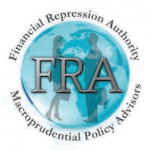
FRA is joined by Uli Kortsch in a discussion of the Monetary Trust Initiative and the underlying problems with the monetary system that lead to its creation.
Uli Kortsch is the Founder of both the Monetary Trust Initiative (MTI) and Global Partners Investments (GPI). Currently most of his time is spent on MTI whose mission is to bring transparency and authentic principles to our monetary system. As President of Global Partners Investments and other ventures, he has worked in over 50 countries, written a bill for Congress, and conferred with approximately 15 national presidents, ministers of finance, and ministers of commerce. He has served on numerous corporate boards with both for-profit and not-for-profit organizations.
HOW MONEY IS CREATED
Almost everyone thinks it’s the Fed that creates money, but it’s not. It’s the commercial, normal banks around the corner from which you borrow money. Almost everyone thinks that money came from a prior saver; it didn’t.
Let’s say you want to buy a Ford for $30,000. You walk in and the banker lends you the money. When you sign the contract that’s an asset to the bank, and let’s assume we now do an intermediation process. The bank takes that $30,000 from a prior saver and moves it into your account. This doesn’t happen, but it’s what most people think. Where did that $30,000 come from? It came from a man who saved the money. But who is that man? It happened to be a man that’s working for Ford and Ford paid the money to the employee, who saved the $30,000 which you now have. What do you do? You give your dealer the $30,000 so you can get the car, and the dealer gives that money to Ford, which gives it to the worker, which gives it to the bank, which gives it to you and—It’s one big circle. The money hasn’t come from anywhere. People don’t think about this. We’re not intermediating money from the previous saver, because the previous saver didn’t exist. Where did they get the money from? The same place you did: the bank.
Then most people think the money came from the Fed, who printed approximately $3T of money over a period of a year and a half, and we run a fractional reserve banking system. Well, no. Those are reserves, and reserves never hit the street. None of us have ever gotten a penny of that. So where does the money come from? Let’s go back to the Ford.
You sign your contract for $30,000 and the bank, out of nothing, creates that $30,000 deposit. That is true in the aggregate and the overall system how it works. In the bank’s bookkeeping, it looks different, but that’s in effect what happens. Let’s reverse the whole process and say the bank charges you 10% interest. You have a really good year and haven’t made any payment. At the end of the year, you pay your whole loan off: you owe the $30,000 loan plus $3,000 in interest. That’s a total of $33,000. What happens with that money? The $3,000 is income to the bank from the money it created out of nothing, the $30,000 that you have now payed off ends up as nothing. The bank, in its bookkeeping, in its aggregate, destroys the $30,000.
We’ve got several things here that are now obvious: 100% of our money is created by debt. It’s what we call bank money verses cash. Almost everything is based on bank money; there’s very little cash out there. There are a few implications to this. We must have an ever increasing level of debt in order to have price stability. In order to have price stability, if GDP grows by 2%, then the monetary aggregates have to grow by 2%. We have to have an ever increasing level of debt, but a lot of economists say one person’s debt is another person’s asset. No, debt creates saving, not the other way around. You have to turn the whole thing on its head: if there was no debt, there’d be no savings.
We know the $30,000 was created by the bank, but where did the $3,000 come from? We’re always short. There is never enough because we always create debt but not interest. The first users of money are always the greatest beneficiaries. In this case, it’s the banks or the people wealthy enough to borrow these funds at ridiculously low interest rates.
INEQUALITIES
Back to reserves, it’s a dual cycle system where two cycles run simultaneously and do not interact. When the Fed creates $3T, we run a fractional reserve banking system at about at 10% reserve ratio. In theory, if it were the Fed creating money through their reserve system, $3T would be the equivalent of $30T on the street. Well, that didn’t happen. What happens is that the FOMC create this “money” on their balance sheets and go out and buy paper – Treasuries and agencies – and goes to the bank because they have to buy from a primary dealer. The bank hands over the Treasury for $1000. Where does that money go? It goes nowhere because it’s an accounting entry that goes from an asset to the Fed to an asset to the bank, but it stays as a reserve.
The effect of inequalities is unbelievable. Agencies are houses and Treasuries are bonds. What we’ve done is forced the market into higher risk and the people who own those assets have gone through the roof. The top 1/10th of 1% is almost the exclusive beneficiary of these trillions of Dollars that have been created. The banking system favors assets. It does not favor labor. It preserves assets and preserves their value. The way to solve this is to change our whole system for greater equality.
These are the biggest issues, and what do we do about it? The question really comes down to money creation. We can get into arguments with the Austrian economists about gold standards or methods of limiting the amount of money production, but that’s secondary.
There are two separate issues: how money is created and how we control that.
You cannot have the second issue without solving the first issue. The first issue, how money is created, we have to take out of the hands of private banks. It is an extraordinary privilege they have: they’re allowed to create money, and they’re allowed to merge their funds with their customer’s funds. No one else is allowed to do that and this is why we have bank runs.
How do we then create money? Some minor examples historically were through sovereign money, the power of the state to create money. The control level is actually much better, because currently we’re printing money and bankers are trying to maximize loans. The only reason they do not issue loans is when they don’t trust the customer or economy. So you have these huge ups and downs in the business cycle as a result of this kind of system. If you get away from banks creating money, you stabilize the system. How do you distribute it? You can do it directly through the government. In theory, the government represents everyone, so if you want to equally hand the money to everyone you give it to the government. Then banks become true intermediaries and depositors. It creates stability in the system because when you have a decreasing economic situation, the government can create the amount of distribution and pull it back later on.
This happened during the American Revolution, when they created Greenbacks to pay for the Civil War and to rebuild the country’s infrastructure after. We could do the same today for infrastructure and not create inflation. It has to be done carefully, and if it does you can stop it or sterilize the funds. We would not be left indebted.
CHALLENGES AND BOTTLENECKS – THE NEXT STEP
The bottlenecks are the smaller banks. Since Dodd-Frank was enacted, about 2000 community banks had gone bust or been forced to merge, because the regulatory expenses are so burdensome that they can’t handle it. Dodd-Frank is not needed under a system of sovereign money, so you don’t need a regulatory oversight like we have now because the system is internally stable. Lawyers and the employees involved in the regulatory system are opposed to this, along with the large banks that disproportionately gain. It’s regulatory capture.
What’s interesting politically is that people who are fairly strongly on the left or right are in favor of this. It’s the people in the middle who aren’t a whole lot that don’t care much socially, who need to be persuaded. There’s a rising level of interest as people start to understand that in effect, we’ve been lied to for the last hundred years about how the system really works. People are starting to get angry.
MONETARY TRUST INITIATIVE
The Monetary Trust Initiative’s goal has been to create a model. Four years ago the plan was Puerto Rico, now it’s New Zealand and some other small places whereby there is monetary autonomy and we can change the system such that it’s a demonstrable model that can be studied. All the attention is going toward that.
It is not currently operational there.
Abstract by: Annie Zhou <a2zhou@ryerson.ca>
LINK HERE to download the MP3 Podcast




 06/22/2017 - The Roundtable Insight: Uli Kortsch On The Monetary Trust Initiative – Why/How It Could Address The Underlying Problems With The Financial System
06/22/2017 - The Roundtable Insight: Uli Kortsch On The Monetary Trust Initiative – Why/How It Could Address The Underlying Problems With The Financial System


